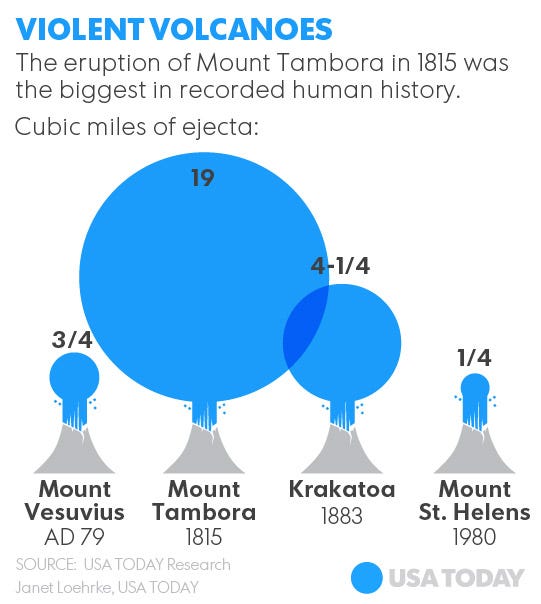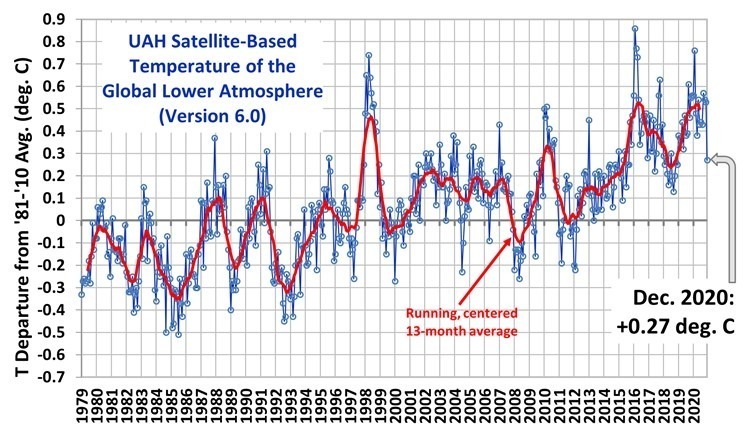
Many people have heard or read about this. It was the result of the massive Tambora volcanic eruption in 1815. This spewed massive amounts of volcanic ash/sufur dioxide into the stratosphere which blocked a great deal of sunshine for several years.
The Earth had already been in a centuries-long period of global cooling that started in the 14th century. Known today as the Little Ice Age, it had already caused considerable agricultural distress in Europe. The Little Ice Age's existing cooling was exacerbated by the eruption of Tambora, which occurred near the end of the Little Ice Age.[17]
This period also occurred during the Dalton Minimum (a period of relatively low solar activity), specifically Solar Cycle 6, which ran from December 1810 to May 1823. May 1816 in particular had the lowest sunspot number (0.1) to date since record keeping on solar activity began. The lack of solar irradiance during this period was exacerbated by atmospheric opacity from volcanic dust.[citation needed]
This spike down in temperatures.......... global cooling, showed us what the real threat to crops and life is on the planet.
https://en.wikipedia.org/wiki/Year_Without_a_Summer
| Year Without a Summer | |
|---|---|
 1816 summer temperature anomaly compared to average temperatures from 1971 to 2000 1816 summer temperature anomaly compared to average temperatures from 1971 to 2000 | |
| Volcano | Mount Tambora |
| Start date | Eruption occurred on 10 April 1815 |
| Type | Ultra-Plinian |
| Location | Lesser Sunda Islands, Dutch East Indies (now Republic of Indonesia) |
| Impact | Caused a volcanic winter that dropped temperatures by 0.4–0.7 °C worldwide |
The year 1816 is known as the Year Without a Summer (also the Poverty Year and Eighteen Hundred and Froze To Death)[1] because of severe climate abnormalities that caused average global temperatures to decrease by 0.4–0.7 °C (0.7–1 °F).[2] Summer temperatures in Europe were the coldest on record between the years of 1766–2000.[3] This resulted in major food shortages across the Northern Hemisphere.[4]
Evidence suggests that the anomaly was predominantly a volcanic winter event caused by the massive 1815 eruption of Mount Tambora in April in the Dutch East Indies (known today as Indonesia). This eruption was the largest in at least 1,300 years (after the hypothesized eruption causing the extreme weather events of 535–536), and perhaps exacerbated by the 1814 eruption of Mayon in the Philippines.
In the spring and summer of 1816, a persistent "dry fog" was observed in parts of the eastern United States. The fog reddened and dimmed the sunlight, such that sunspots were visible to the naked eye. Neither wind nor rainfall dispersed the "fog". It has been characterized as a "stratospheric sulfate aerosol veil".[25]
The weather was not in itself a hardship for those accustomed to long winters. The real problem lay in the weather's effect on crops and thus on the supply of food and firewood. At higher elevations, where farming was problematic in good years, the cooler climate did not quite support agriculture. In May 1816,[1] frost killed off most crops in the higher elevations of Massachusetts, New Hampshire, and Vermont, as well as upstate New York. On June 6, snow fell in Albany, New York, and Dennysville, Maine.[21] In Cape May, New Jersey, frost was reported five nights in a row in late June, causing extensive crop damage.[26] New England also experienced major consequences from the eruption of Tambora. Though fruits and vegetable crops survived, corn was reported to have ripened so poorly that no more than a quarter of it was usable for food. This moldy and unripe harvest wasn't even fit for animal feed.[18] The crop failures in New England, Canada, and parts of Europe also caused the price of many staples to rise sharply. In Canada, Quebec ran out of bread and milk and Nova Scotians found themselves boiling foraged herbs for sustenance.[18]
A Massachusetts historian summed up the disaster:
Severe frosts occurred every month; June 7th and 8th snow fell, and it was so cold that crops were cut down, even freezing the roots ... In the early Autumn when corn was in the milk it was so thoroughly frozen that it never ripened and was scarcely worth harvesting. Breadstuffs were scarce and prices high and the poorer class of people were often in straits for want of food. It must be remembered that the granaries of the great west had not then been opened to us by railroad communication, and people were obliged to rely upon their own resources or upon others in their immediate locality.[29]
In July and August, lake and river ice was observed as far south as northwestern Pennsylvania. Frost was reported as far south as Virginia on August 20 and 21.[30] Rapid, dramatic temperature swings were common, with temperatures sometimes reverting from normal or above-normal summer temperatures as high as 95 °F (35 °C) to near-freezing within hours. Thomas Jefferson, retired from the presidency and farming at Monticello, sustained crop failures that sent him further into debt. On September 13, a Virginia newspaper reported that corn crops would be one half to two-thirds short and lamented that "the cold as well as the drought has nipt the buds of hope".[
The eruption of Tambora, on April 10, 1815, on the island of Sumbawa in what's now Indonesia, was 100 times more powerful than the 1980 Mount St. Helens blast, according to the U.S. Geological Survey, which ranked the eruption as a seven on its eight-level volcanic explosivity index.
The volcano spewed out enough ash and pumice to cover a square area 100 miles on each side to a depth of almost 12 feet, according to the book, The Year without Summer, by Klingaman and his father, William K. Klingaman.

If the eruption is strong enough, it shoots that sulfur dioxide high into the stratosphere, more than 10 miles above Earth's surface. Up there, sulfur dioxide reacts with water vapor to form sulfate aerosols.
Because these aerosols float above the altitude of rain, they don't get washed out. Instead they linger, reflecting sunlight and cooling the Earth's surface, which is what caused the weather and climate impacts of Tambora's eruption to occur more than a year later.
Eruptions on the scale of Tambora occur once every 1,000 years on average, but smaller events can still substantially impact the climate, Klingaman said. Krakatoa's 1883 eruption in Indonesia caused global cooling nearly five years later, even though it ejected less material into the atmosphere than Tambora.
Similarly, Pinatubo in 1991 in the Philippines caused global temperatures to cool by about 1 degree, Klingaman said. Eruptions of that magnitude — about one-sixth the size of the Tambora eruption — happen about once every 100 years.
"Any of those other volcanoes could erupt again, perhaps on a scale of Tambora or greater," said Mike Mills, an atmospheric chemist at the National Center for Atmospheric Research in Boulder, Colo.
The subject of how volcanoes affect climate is relatively new: Scientists didn't confirm the link between volcanic eruptions and global cooling until the 1960s and 1970s, Klingaman said.
A new area of research delves into how volcanic eruptions could interact with global warming, Mills said. The chemist says his own investigation found the role of volcano eruption in global climate change could be underestimated. And it could help explain why global warming appeared to temporarily slow down early this century when volcanic activity increased.
With global temperatures at record highs, a massive eruption today could halt man-made climate change. But the effect would be only temporary: Warming would pick up where it left off once all the stratospheric dust settled out, a process that could a few years or up to a decade, Weather Underground reported.
The fallout on the people affected by the event, though, could last far longer. The colorful, dusty skies from Tambora's epic blast inspired some of British artist J. M. W. Turner's most spectacular sunset paintings — some of which were painted decades after the eruption.
Global cooling like that caused by Tambora is the main threat.
This kind of slight warming has been mostly beneficial.
http://www.drroyspencer.com/latest-global-temperatures/

https://wattsupwiththat.com/2021/01/02/uah-global-temperature-update-for-december-2020-0-27-deg-c/